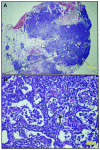The protective effect of the Mycobacterium bovis BCG vaccine is increased by coadministration with the Mycobacterium tuberculosis 72-kilodalton fusion polyprotein Mtb72F in M. tuberculosis-infected guinea pigs
- PMID: 15501795
- PMCID: PMC523007
- DOI: 10.1128/IAI.72.11.6622-6632.2004
The protective effect of the Mycobacterium bovis BCG vaccine is increased by coadministration with the Mycobacterium tuberculosis 72-kilodalton fusion polyprotein Mtb72F in M. tuberculosis-infected guinea pigs
Abstract
A tuberculosis vaccine candidate consisting of a 72-kDa polyprotein or fusion protein based upon the Mtb32 and Mtb39 antigens of Mycobacterium tuberculosis and designated Mtb72F was tested for its protective capacity as a potential adjunct to the Mycobacterium bovis BCG vaccine in the mouse and guinea pig models of this disease. Formulation of recombinant Mtb72F (rMtb72F) in an AS02A adjuvant enhanced the Th1 response to BCG in mice but did not further reduce the bacterial load in the lungs after aerosol challenge infection. In the more stringent guinea pig disease model, rMtb72F delivered by coadministration with BCG vaccination significantly improved the survival of these animals compared to BCG alone, with some animals still alive and healthy in their appearance at >100 weeks post-aerosol challenge. A similar trend was observed with guinea pigs in which BCG vaccination was boosted by DNA vaccination, although this increase was not statistically significant due to excellent protection conferred by BCG alone. Histological examination of the lungs of test animals indicated that while BCG controls eventually died from overwhelming lung consolidation, the majority of guinea pigs receiving BCG mixed with rMtb72F or boosted twice with Mtb72F DNA had mostly clear lungs with minimal granulomatous lesions. Lesions were still prominent in guinea pigs receiving BCG and the Mtb72F DNA boost, but there was considerable evidence of lesion healing and airway remodeling and reestablishment. These data support the hypothesis that the coadministration or boosting of BCG vaccination with Mtb72F may limit the lung consolidation seen with BCG alone and may promote lesion resolution and healing. Collectively, these data suggest that enhancing BCG is a valid vaccination strategy for tuberculosis that is worthy of clinical evaluation.
Figures








Similar articles
-
Differential immune responses and protective efficacy induced by components of a tuberculosis polyprotein vaccine, Mtb72F, delivered as naked DNA or recombinant protein.J Immunol. 2004 Jun 15;172(12):7618-28. doi: 10.4049/jimmunol.172.12.7618. J Immunol. 2004. PMID: 15187142
-
Evaluation of the Mtb72F polyprotein vaccine in a rabbit model of tuberculous meningitis.Infect Immun. 2006 Apr;74(4):2392-401. doi: 10.1128/IAI.74.4.2392-2401.2006. Infect Immun. 2006. PMID: 16552069 Free PMC article.
-
Mouse and guinea pig models for testing new tuberculosis vaccines.Tuberculosis (Edinb). 2005 Jan-Mar;85(1-2):13-7. doi: 10.1016/j.tube.2004.08.001. Epub 2005 Jan 22. Tuberculosis (Edinb). 2005. PMID: 15687022
-
[Novel vaccines against M. tuberculosis].Kekkaku. 2006 Dec;81(12):745-51. Kekkaku. 2006. PMID: 17240920 Review. Japanese.
-
Immunization strategies against pulmonary tuberculosis: considerations of T cell geography.Adv Exp Med Biol. 2013;783:267-78. doi: 10.1007/978-1-4614-6111-1_14. Adv Exp Med Biol. 2013. PMID: 23468114 Review.
Cited by
-
Tracking antigen-specific CD8 T lymphocytes in the lungs of mice vaccinated with the Mtb72F polyprotein.Infect Immun. 2005 Sep;73(9):5809-16. doi: 10.1128/IAI.73.9.5809-5816.2005. Infect Immun. 2005. PMID: 16113299 Free PMC article.
-
Poly (lactide-co-glycolide) microspheres in respirable sizes enhance an in vitro T cell response to recombinant Mycobacterium tuberculosis antigen 85B.Pharm Res. 2007 Oct;24(10):1834-43. doi: 10.1007/s11095-007-9302-8. Epub 2007 Jul 27. Pharm Res. 2007. PMID: 17657598
-
Next-Generation Vaccines Based on Bacille Calmette-Guérin.Front Immunol. 2018 Feb 5;9:121. doi: 10.3389/fimmu.2018.00121. eCollection 2018. Front Immunol. 2018. PMID: 29459859 Free PMC article. Review.
-
Comparison of BCG prime-DNA booster and rBCG regimens for protection against tuberculosis.Hum Vaccin Immunother. 2014;10(2):391-8. doi: 10.4161/hv.26969. Epub 2013 Nov 5. Hum Vaccin Immunother. 2014. PMID: 24192709 Free PMC article.
-
RNA vaccines: The dawn of a new age for tuberculosis?Hum Vaccin Immunother. 2025 Dec;21(1):2469333. doi: 10.1080/21645515.2025.2469333. Epub 2025 Feb 27. Hum Vaccin Immunother. 2025. PMID: 40013818 Free PMC article. Review.
References
-
- Behr, M. A., and P. M. Small. 1997. Has BCG attenuated to impotence? Nature 389:133-134. - PubMed
-
- Behr, M. A., and P. M. Small. 1999. A historical and molecular phylogeny of BCG strains. Vaccine 17:915-922. - PubMed
-
- Behr, M. A., M. A. Wilson, W. P. Gill, H. Salamon, G. K. Schoolnik, S. Rane, and P. M. Small. 1999. Comparative genomics of BCG vaccines by whole-genome DNA microarray. Science 284:1520-1523. - PubMed
-
- Bloom, B. R., and C. J. Murray. 1992. Tuberculosis: commentary on a reemergent killer. Science 257:1055-1064. - PubMed
Publication types
MeSH terms
Substances
Grants and funding
LinkOut - more resources
Full Text Sources
Other Literature Sources

